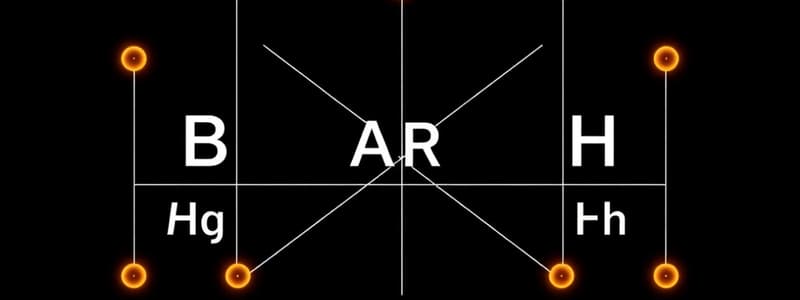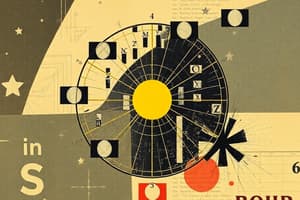Podcast
Questions and Answers
Which of the following formulas represents an ionic compound?
Which of the following formulas represents an ionic compound?
- CH₄
- N₂O₃
- SF₆
- MgCl₂ (correct)
Which of these compounds is composed of two nonmetal elements?
Which of these compounds is composed of two nonmetal elements?
- Cu₂O
- Pb(NO₃)₂
- Be₃P₂
- CO (correct)
Which of the following compounds, when dissolved in water, will conduct electricity?
Which of the following compounds, when dissolved in water, will conduct electricity?
- SnS
- H₂O₂
- Na(OH) (correct)
- CH₄
Which formula represents a compound that contains a polyatomic ion?
Which formula represents a compound that contains a polyatomic ion?
What is the valence charge of a sulfur ion?
What is the valence charge of a sulfur ion?
Which of the following is a binary acid?
Which of the following is a binary acid?
Which of the following ions has a +3 valence charge?
Which of the following ions has a +3 valence charge?
What is the valence charge of an ion formed from an alkaline earth metal?
What is the valence charge of an ion formed from an alkaline earth metal?
What is the valence charge of the metal ion in $Fe_2O_3$?
What is the valence charge of the metal ion in $Fe_2O_3$?
What type of reaction is represented by Pb(NO₃)₂ + Na₂SO₄ → PbSO₄ + NaNO₃?
What type of reaction is represented by Pb(NO₃)₂ + Na₂SO₄ → PbSO₄ + NaNO₃?
Which of the following is a product of the reaction between strontium hydroxide and lead (II) bromide?
Which of the following is a product of the reaction between strontium hydroxide and lead (II) bromide?
What type of reaction is the combustion of propane (C₃H₈) with oxygen?
What type of reaction is the combustion of propane (C₃H₈) with oxygen?
What are the products of the reaction between aluminum iodide and bromine?
What are the products of the reaction between aluminum iodide and bromine?
Which of the given reactions is a decomposition reaction?
Which of the given reactions is a decomposition reaction?
Which of the following reactions would be classified as a single displacement reaction?
Which of the following reactions would be classified as a single displacement reaction?
What are the products when glucose reacts with oxygen?
What are the products when glucose reacts with oxygen?
What type of reaction is the combination of lithium with oxygen?
What type of reaction is the combination of lithium with oxygen?
Flashcards
Valence Charge
Valence Charge
The charge of an ion determined by how many electrons it has gained or lost.
Polyatomic Ion
Polyatomic Ion
A group of atoms that act together as a single unit with a charge.
Multivalent Metal
Multivalent Metal
A metal that can have multiple possible valence charges.
Acid
Acid
Signup and view all the flashcards
Ionic Compound
Ionic Compound
Signup and view all the flashcards
What does the symbol (aq) indicate?
What does the symbol (aq) indicate?
Signup and view all the flashcards
What is a word equation?
What is a word equation?
Signup and view all the flashcards
What is a balanced chemical equation?
What is a balanced chemical equation?
Signup and view all the flashcards
What is balancing a chemical equation?
What is balancing a chemical equation?
Signup and view all the flashcards
What are reactants?
What are reactants?
Signup and view all the flashcards
Decomposition Reaction
Decomposition Reaction
Signup and view all the flashcards
Synthesis Reaction
Synthesis Reaction
Signup and view all the flashcards
Single Displacement Reaction
Single Displacement Reaction
Signup and view all the flashcards
Double Displacement Reaction
Double Displacement Reaction
Signup and view all the flashcards
Combustion Reaction
Combustion Reaction
Signup and view all the flashcards
Neutralization Reaction
Neutralization Reaction
Signup and view all the flashcards
Cellular Respiration
Cellular Respiration
Signup and view all the flashcards
Chemical Reaction
Chemical Reaction
Signup and view all the flashcards
Study Notes
Bohr-Rutherford Diagrams and Valence Charges
- Bohr-Rutherford diagrams are used to illustrate the arrangement of electrons around an atom's nucleus.
- Valence charge refers to the ionic charge an atom gains or loses in order to achieve a stable electron configuration
- Students are to draw diagrams and determine the valence charge of ions for specific elements (e.g., sodium, sulfur, aluminum, fluorine).
Ions and Valence
- Ions are atoms that have gained or lost electrons, resulting in a positive or negative charge.
- Valence is the combining power of an element, often reflected in the ionic charge.
- Students should identify the valence of various ions (e.g., potassium, oxide, iron (III), phosphorus, carbonate, ammonium, chloride, silver, hydroxide, sulfate).
Acids and Compounds
- Compounds that are acids, along with their names, are to be identified via a wavy underline.
- Polyatomic ions and their formulas and valence charges are to be identified via a double underline on the compounds
- Multivalent metals require a star next to the compound
- Formulas for non-polyatomic/non-multivalent-metal compounds are to be written.
- (aq) beside a formula for an acid means it's dissolved in water (aqueous).
Differences Between Molecular and Ionic Compounds
- Ionic compounds conduct electricity, while molecular compounds do not.
- Ionic compounds dissolve in water, molecular compounds may or may not.
- Ionic compounds have a crystal structure; molecular compounds don't.
- Ionic compounds form from a metal and a nonmetal, molecular from two nonmetals.
Balancing Chemical Equations
- Students need to write the word equation and balance equations for given skeleton chemical equations.
- Examples include reactions involving lead (II) nitrate and sodium sulfate, forming lead sulfate and sodium nitrate.
Chemical Reactions and Types
- Students must identify types of chemical reactions (e.g., synthesis, decomposition, combustion, single displacement, double displacement, neutralization).
- Various examples of reactions, including those involving magnesium, aluminum, copper, propane, calcium carbonate etc. have various products.
- The study should involve synthesis reactions, predicting products, and identifying cellular respiration.
Studying That Suits You
Use AI to generate personalized quizzes and flashcards to suit your learning preferences.




